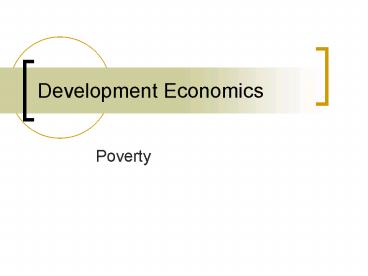Development Economics - PowerPoint PPT Presentation
1 / 24
Title:
Development Economics
Description:
Most of the world's poor people earn their living from ... United Arab Emirates. 0.849. 78.0. 77.3. 74. 22,420 -18. 52. Cuba. 0.817. 77.3. 96.9. 80. 40. 53 ... – PowerPoint PPT presentation
Number of Views:557
Avg rating:3.0/5.0
Title: Development Economics
1
Development Economics
- Poverty
2
Poverty
- Most of the people in the world are poor, so if
we knew the economics of being poor we would know
much of the economics that really matters. Most
of the worlds poor people earn their living from
agriculture, so if we know the economics of
agriculture, we would know much of the economics
of being poor - T.W. Schultz (1980)
3
Measuring poverty
- Subjective or qualitative method Participatory
Rural Assessment self-assessment. - Definition of poverty lines based on income or
consumption
4
Relative or absolute poverty
- Absolute poverty notion of basic needs. Includes
achieving full participation in the society. The
necessary income level to satisfy these needs
depends on the level of development of the
economy. - Poor people are often treated badly by the
institutions of state and society and excluded
from voice and power in those institutions (WDR
2000) - Relative poverty poverty lines is defined as a
function of income distribution in the economy. - E.g. ,people are identified as poor if they live
with less than half the median (or mean) income.
5
Nutrition based definition.
- Cost of buying enough to eat.
- Rowntree (1901) Poor families are those where
total earnings are insufficient to obtain the
minimum necessities for the maintenance of merely
physical efficiency - But there are other basic needs (clothing,
housing) - In 1999, the average rural indian household
dedicated 62 of its expenditures to food,
against 70 in 1983. - With growth, it becomes difficult to think of
poverty entirely in terms of food. (Engels law).
6
- Nevertheless, taking into account the nutritional
needs to define poverty remains an accepted idea. - Many countries calculate poverty lines by
computing the minimal cost to obtain 2000
calories a day. - But this is obtained with a monotonous and
uninteresting, and hence unacceptable diet
(Stigler 1945). - Other solution look at what people actually eat
and estimate the relation between the calories
content of the food and the (log of) total
expenditures ( calorie Engel curve ). The cost
of obtaining 2000 calories is infered from this
estimation.
7
(No Transcript)
8
Limits
- Nutritional needs might not be the same for
everyone (men, women, children). - Consumption is measured at the household level
and not at the individual level - Household structure needs to be taken into
account - Intra-household resource allocation
- Agregating rural and urban areas
- Price differences between areas, between social
categories - Actualisation is needed for both inflation and
structural changes.
9
- Whatever the definition, there is some
arbitrariness in considering two individuals with
very similar incomes but situated on each side of
the poverty line as being in fundamentally
different situations. - Researchers have tried to see whether
discontinuity in behaviour could be observed so
as to endogeneously determine a poverty line, but
unsuccessfully.
10
Poverty measures some desirable characteristics
- Monotonicity (the increase of the income of a
poor people must reduce the index) - Any regressive transfer through the poverty line
should induce an increase in the poverty index,
and the more so that the individual transferring
income is far from the poverty line (transfer
sensitivity). - Population principle
- The index must increase if the propostion of poor
increases. - Decomposability if poverty increases in a
sub-group of the population, the agregated index
must increase as well. - The index must not be affected by income levels
above the poverty line.
11
Measures.
- let z be the poverty line.
- FGT family of indices
- P??yiltz(z-yi)?/nz?
- If ?0, P is the Headcount ratio, number of poor
people/total population. - Easy to communicate, but not sensitive to income
distribution below the poverty line.
12
- If ?1, P is the Poverty Gap
- It represent the total transfer that would be
necessary to bring all the poor to the poverty
line level (sometimes expressed as a proportion
to mean income). - It is not sensitive to regressive transfers among
the poor.
P1?yiltz(z-yi)/nz
13
- If ?2,
- If poor is assigned a weight equal to the
distance between his income and the poverty line.
- If ??, only the income of the poorest is taken
into account. - Sens index SP0GP1(1-G)
- where G Gini coefficient among the poor.
P2?yiltz(z-yi)2/nz2
14
(No Transcript)
15
(No Transcript)
16
(No Transcript)
17
(No Transcript)
18
(No Transcript)
19
(No Transcript)
20
(No Transcript)
21
(No Transcript)
22
23
Vulnerability
- Risk for an individual or a household to face one
episode of poverty. - Measure?
- Coefficient of variation of income
- Negative shocks and positive shocks are dealt
with in a symmetrical way - No temporal dimension
- Set of indicators related to the capacity to face
negative shocks assets ownership, income
diversification, social network, access to credit
and insurance)
24
Functional impact of poverty
- Notion of poverty traps
- Difficulties to access credit (no collateral),
and hence - No possibility to realize investments that could
be productive in the future - No possibility to optimally invest in education.
- Efficiency wages undernourished individuals are
less productive and then less capable of
generating income.































